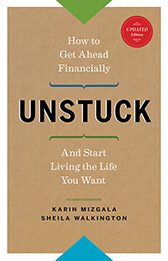co-founder and CEO Money Coaches Canada

In the conversations we’ve had with our clients in recent weeks, there is certainly concern and questions about the market and economic fallout from COVID-19, high inflation, and rising interest rates as central banks respond, but most are staying the course with their investment plan.
And perhaps that’s the point. They have an investment and financial plan. While no one could have anticipated the timing and severity of the pandemic and its economic after effects, our clients do have a plan (that is based on realistic rate of return assumptions) that takes the ups and downs of the market into consideration. They have the comfort of knowing that the investment and financial decisions they have made so far are based on a full analysis of their goals, values and their personal and financial circumstances.
During the depths of the pandemic, a client of my colleague Sheila summed it up: “we are grateful we have had your guidance for so long and can focus on health instead of worrying about money at a time like this”.
In fact, we’ve had more questions from clients about whether this is a good time to invest with money they have sitting in cash.
As of the beginning of June, many stocks are down by double digit percentages – some well into the double digits – from their 2021 highs. Is this a great buying opportunity?
While we’ll only know in hindsight when we’ve reached bottom, here are a few things I know for sure if you are considering investing now.
- Make sure you have a strong financial foundation
Unless you have an emergency fund of 6 months of expenses and little or no non-mortgage debt, don’t invest now. There may be “deals” out there in the market but with the uncertainty in the economy it’s better to hold on to cash and work towards being debt-free. You can always invest later.
- Get real with risk
The breathtaking speed and magnitude of the market drop in 2020 and the rollercoaster ride in the markets since then may have been a big wake-up call for you. It’s natural to feel a punch, but how hard was the hit for you?
Did it keep you up at night? Or did you think – “stocks are on sale now”? Maybe it was more of an “ouch, but this is what markets do and I’m in it for the long haul anyway”?
If your reaction was sharply negative, this could mean that you either need a better plan and understanding of the markets or it could simply mean that you don’t have the stomach for stock market volatility.
What it comes down to is this: How much risk do I need to take to achieve my goals?
If you can achieve your long-term goals with cash or GIC investments earning low-to-mid single digit returns, then you might choose to forgo investing in the stock market. But if you’re like most people, this return won’t cut it after inflation – especially the much higher inflation we’ve been experiencing the last two years – and you have little choice but to include an appropriate mix of cash, stocks and bonds in your portfolio.
Steadyhand’s Tom Bradley shares some great lessons about risk and bear markets from one of his investment heroes.
- Think long term
The longer the time period before you need to use the money from your investments, typically the more risk you can take. If you need the money you’re thinking of investing now within 5-7 years, then skip the stock market. Hold it in cash or GICs instead.
And remember that even if you are close to retirement or already retired, you likely won’t need all your money in the next 10 years so some stock holdings could still be appropriate for you.
- Review your current investments
Before investing more money in the markets, make sure that you have a good handle on how you are currently invested and how your portfolio is being managed now.
- How is your current portfolio faring relative to the overall markets?
- What fees are you paying?
- Are your investments the right fit for you?
- Do you have confidence in your investment advisor?
Check out How to Invest Like A Professional.
- Make a solid investment plan
The key to feeling confident about your investment decisions especially in volatile times is about having a well-thought-out Investment Plan. Your Investment Plan will support your ability to make sound decisions, rather than making decisions based on emotions or market fluctuations, whether they be positive or negative.
Your plan needs to consider:
- What the money is for
- When you will need the money
- Whether to invest in RSPs, TFSAs or non-registered accounts
- What investments would best suit your goals
- Whether your risk tolerance is compatible with these investments
The answers to these questions will help you (and your advisor if you choose to work with one) create an Investment Plan that will form the structure and context for deciding which investments are most suited to your needs.
- Hedge your bets
Given the high level of uncertainty with the markets and the potential for increased volatility, you may want to consider investing funds available for long-term investing in even intervals over the next 6 months or a year.
Even though many stocks have taken a hit recently, this might not be the lowest point. That said, waiting too long could mean that you miss the upside along the way.
Over the long run it may not matter much to reaching your retirement or other long-term goals whether you invested in a lump sum or if you invested in intervals, but it may help your anxiety to not see a large investment take a hit right after investing.
- Stay engaged but not obsessive
While you may have left your investments entirely up to your advisor in the past, the recent market turbulence is a reminder of the risks of not having a portfolio that matches your goals and investor profile.
You don’t have to check your investments daily or become a do-it-yourself investor, but you do need to stay in touch with your advisor through good times and bad and monitor your portfolio using metrics like performance against market benchmarks, asset mix, and alignment to your goals.
For an independent, unbiased investment review and plan, check out the On your Side Investment Report Card™.
This post first appeared in 2020. It has been updated with current data and/or new information and republished.



Investing in a PPP makes a lot of sense.